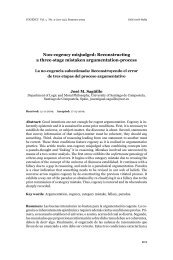Cogency v2 n2
Cogency v2 n2
Cogency v2 n2
You also want an ePaper? Increase the reach of your titles
YUMPU automatically turns print PDFs into web optimized ePapers that Google loves.
“A picture held us Captive”: The later Wittgenstein... / S. W. PATTERSON<br />
argumentation that frames the image in such a way that one can see it as a<br />
part of the argumentation too. The work that that the visual image does<br />
therein may vary, but it can do work. The mistake, by Wittgensteinian lights,<br />
simply lies in thinking that because an image does some work in argumentation<br />
it thereby becomes an argument. Whatever else it can do, the visual<br />
image cannot do this. This is largely owing to three reasons: 1) images, though<br />
they are productive of epistemic feelings in us, do not lead us to conclusions<br />
by rational means, 2) even if we allow for contextual influences on interpretation,<br />
images always allow the drawing of multiple valid readings between<br />
which there is no a priori method of adjudication, and 3) the business of<br />
“seeing an image as__” is more a business of erecting a conceptual scaffolding<br />
around it for the purpose of arriving at a particular reading of it than it is<br />
of unlocking a fixed but hidden meaning lying within it. This is why, for<br />
Wittgenstein, it is a bad thing if “a picture holds us captive” with respect to<br />
our efforts to determine the meaning of a word or expression, and why we<br />
need a community of language users playing the same (or similar enough)<br />
language games by the same (or a similar enough) system of rules in order<br />
to speak meaningfully of the meaning of a word or expression.<br />
It would be easy for someone to take the remark that pictures are less<br />
bound by rules of interpretation than words as a sort of slur, as what George<br />
Roque (2009) has called “linguistic imperialism”. If this is an implication of<br />
Wittgenstein’s view, the anti-linguistic-imperialist might say, then so much<br />
the worse for Wittgenstein. But I think this would be a mistake, for in<br />
Wittgenstein’s view is a tacit acknowledgement of the power of images that<br />
the visual argumentation theorist should find salutary. Images may not contain<br />
arguments on this view, but this does not mean that images are inferior<br />
to words. In fact, I would argue that it is the other way ‘round. It is the<br />
semantic polyvalence of images, their ability to carry multiple meanings and<br />
interpretations; the different ways in which we may see them that gives<br />
images their power. And, I would hasten to add, it is not as though there are<br />
no boundaries to the interpretation of images, that some ways of seeing (as<br />
with some ways of speaking) are not perhaps more accurate than others.<br />
The quotation from Gill to the effect that the open-textured nature of images<br />
need not collapse into a relativism about them given in the last section<br />
of the paper is one worth keeping in mind.<br />
Consider, for example, a still life painting by Cézanne (Figure 3).<br />
129








